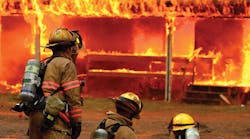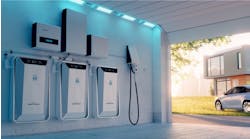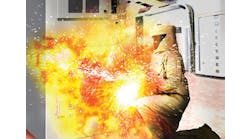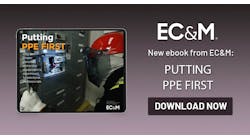Firestop Awareness for Electrical Engineers and Contractors
Every year, thousands of injuries and fatalities — and billions of dollars in property damages — are incurred through structure fires. A National Fire Protection Association (NFPA) report reveals U.S. structure fires in 2011 accounted for 35% of fires that resulted in 2,640 deaths, 15,635 injuries, and $9.7 billion in property damage. Many of these fire-related deaths/damages are attributable to poor flame and smoke containment that occurs with inadequately sealed joints and penetrations for plumbing, HVAC, electrical, and communications infrastructure.
“A significant number of commercial buildings today either don’t have the proper firestop systems installed at the penetrations and fire-rated joints, or they were improperly installed,” said Patrick Tesche, VP of compartmentalization services for fire/life safety engineering and third-party inspection firm, Telgian Corp., Tempe, Ariz., and the task group chair for firestop inspectors qualifications standards on the American Society of Testing and Materials (ASTM-International) E06 technical committee.
With improved firestop systems specifications and installations, these catastrophes could be reduced significantly. Still, there are several reasons code-compliant firestop materials and methods aren’t used in building projects, such as a lack of awareness and education in the construction industry. Also, many times the temptation and convenience of using easily accessible materials already available on-site, such as fiberglass insulation, foam, and other non-compliant sealants, are substituted for listed firestop materials.
To improve awareness, the International Firestop Council (IFC), a not-for-profit trade association of manufacturers, distributors, inspectors, and installers of passive fire protection materials and systems, in conjunction with Underwriters Laboratories (UL), released a public service video on the importance of installing firestop systems in new and retrofit construction projects last November (Photo 1). Available for viewing at www.firestop.org, “Close Enough, Is Not Good Enough: A Demonstration of Proper vs. Improper Firestopping” outlines the proper systems, materials, and methods for sealing wall, ceiling, and floor penetrations and joints for optimum passive containment of smoke and flame during building fires.
“The intent of the IFC and UL is to educate every person associated with building construction on the dangers of using ineffective firestop sealing materials and improper installation techniques in wall, ceiling, and floor penetrations and joints,” said John Valiulis, a Tulsa, Okla.-based fire protection engineer, who assisted in the UL-IFC demonstration test project and video. “If this video helps save just one life, and we believe it will save many, we’ve reached our goal.”
In just over six minutes, the video depicts a full-scale room fire at UL’s Northbrook, Ill., test facility, and visually compares non-compliant firestop systems performance to compliant firestop penetration and joint systems in accordance with ASTM E814 (UL-1479) and ASTM E1966 (UL-2079), respectively. While the test’s compliant firestop systems weren’t breached, the failing non-compliant systems allowed smoke and flame to migrate dangerously to adjacent spaces.
“This video suggests all property managers should inspect existing buildings for non-compliant penetration and joint firestop materials in their fire-rated walls and floors,” said Valiulis. “Likewise, we want all architects, consulting engineers, contractors, and building inspectors to view this video in hope of saving lives.”
Ignited by a fire
Regulation of firestop systems in buildings dates to the March 22, 1975, fire at Browns Ferry Nuclear Power Plant, located near Decatur, Ala. An original penetration seal had been breached to install additional cables required by a design modification. Site personnel were resealing the penetration after cable installation and were checking the airflow through a temporary seal with a candle flame prior to installing the permanent sealing material. The temporary sealing material was highly combustible, and caught fire.
Efforts were made by the workers to extinguish the blaze at its origin, but they apparently did not recognize that the fire, under the influence of the draft through the penetration, was spreading on the reactor building side of the wall. The extent of the fire in the room they were in was limited to a few feet from the penetration; however, the presence of fire on the other side of the wall from the point of ignition was not recognized until significant damage to cables related to the control of Units 1 and 2 had occurred.
The fire caused a direct loss estimated at $10 million and an indirect loss estimated around $300 to $500 million for an 18-month recovery process. Much of this loss was due to the need to purchase power from alternate suppliers and the loss of a return on the Tennessee Valley Authority’s $1 billion investment in the power plant for a period of 18 months.
This event eventually resulted in the Nuclear Regulatory Commission bulking up the standards for fire protection in the nuclear field, and also led the way for firestop regulations in commercial and industrial construction. The International Building Code (IBC)’s Chapter 7, “Fire and Smoke Protection Features,” outlines the requirements for fire resistance-rated assemblies and passive fire protection, including firestopping, for the various construction types. The sections in Chapter 17 provide detailed information on special inspections, including those for firestop systems (see SIDEBAR: IBC Chapter 17). Firestop systems for maintenance and retrofit of existing buildings are covered in Sec. 703 of the International Fire Code.
Although firestop regulations have grown from a blurb in a specification to an entire specification, the proper materials and procedures are still greatly misunderstood. Brice Miller, executive director of IFC, who has been involved in building inspection and building inspector education for 30 years, estimates that the majority of building department inspectors who he approaches for education from his organization don’t understand firestopping.
“They don’t understand what they should be looking at,” he says.
As a result, construction professionals have been getting away with not complying with firestop standards (Photo 2).
“They haven’t had to worry about the inspections,” says Miller, revealing that this is about to change.
IFC offers training for code officials on the importance of proper firestopping materials and techniques.
“They’re starting to get educated,” he says. “That’s our goal: to educate code officials around the country.”
Architects, engineers, and contractors are welcome in IFC’s free training sessions. That way, contractors won’t be in for a surprise when the code inspector brings up firestopping during the inspection.
“The emphasis on firestopping is getting out there where these code professionals are starting to look at it,” says Miller. “So now the trades are getting caught off guard. They haven’t had to worry about this before, but now they do, so they’re asking ‘How do get this done so our project isn’t held up?’ We don’t want them to start getting held up because they didn’t do the firestopping properly, but that’s something that does happen.”
Not rocket science
Founded in 1999, the Firestop Contractors International Association (FCIA) recognized the need for a standard qualification program. The organization has developed in conjunction with FM Approvals, FM 499,1 “Standard for Approval of Firestop Contractors.” This program, a quality process program specifically designed for firestopping contractors, requires specific, tangible installation procedures that the firestop contractor follows routinely on its projects.
UL also administers two qualified firestop contractor programs for contractors who install firestop systems: UL Qualified Firestop Contractor Program and ULC Qualified Firestop Contractor Program. The two programs vary only in knowledge requirements related to the difference between U.S. and Canadian codes and standards.
But without the intention of becoming a firestop contractor, Miller doesn’t necessarily recommend either qualification for electrical contractors.
“Certification is very involved,” he says, citing that it costs a firm between $4,000 and $6,000 to become qualified or approved by either FM or UL, not including the time taken away from operations.
“The firestop installers, that’s all they do,” Miller continues. “If I were a code official in a jurisdiction, and I knew an electrical contractor had his qualification through the UL or FM, I don’t think it would make that much difference to me.”
Yet, most firestopping installations are performed by subcontractors.
“We know that around 80% of the work on firestopping is being done by the trades,” Miller says. “Do they do as good a job as a firestop installer? That’s hard to say. There are some that do a fantastic job, and then there are others that make you wonder why they are even doing this work.”
The insulation building trade includes firestop installation, theory, and practical training within its apprenticeship program. The International Brotherhood of Electrical Workers (IBEW) requires composite crews to oversee the work when it’s near live electrical conductors. An electrician is required to observe and ensure the safety of the insulator. However, convenience sometimes, tragically, gets in the way.
“The problem is a lot of the contractors in the trades, unfortunately, just use the caulk gun and fill up the hole,” says Miller. “That isn’t the way you do it. You have to read the plans. You have to make sure you’re putting this in properly, so it’s safe. You follow the listed instructions in front of you, and install it properly. Really, it’s not that hard. It’s not rocket science.”
FCIA has published its Manual of Practice (MOP), a compilation of firestopping knowledge written by FCIA members and staff. The manual, which is also the basis for the FM 4991 examination, provides a resource for industry education, including firestop contractor firms, manufacturers, distributors, architects, engineers, or trade contractors.
Holes in the wall
Proper installation of firestop systems starts long before the contractor begins work on the actual installation. Electrical contractors should be working from the plans, which contain the firestop materials and their UL listing.
“Firestopping starts with the designer,” says Miller. “The paperwork tells the contractors exactly what to do. It’s the instruction manual. If you’ve got electrical systems going through a penetrating wall, they can list all those systems. This should be on the plans — the assembly, the penetrating item, and the material. Those three components should be on those plans. That is the key to get these firestopping systems installed properly.”
However, Miller estimates that only about 5% of designers actually include firestop systems in their plans. But the best plans could avert the need for firestop systems altogether. There are instances, such as when using integrated project delivery (IPD) methods, where the electrical engineer, working early with the architect, can design a power system layout that won’t require a firestop system. If the design does not have the conduit penetrating the rated partition, then no firestop system is needed. However, this isn’t possible or practical in many cases.
If you can’t avoid penetrating a rated wall, then the designer had better plan for it. To properly select a firestopping system, the power system designer should discuss the rated assemblies and their construction with the architect. The rating of the assembly, the construction materials being used, and the thickness and spacing of structural supports can affect the selection of the firestopping system.
The type of rated wall may have been specified before the selection of the electrical gear and the determination of its distribution. This happens in cases of fast-track schedules or long-term phasing of the project. Access can also be a challenge. Conduit, cable tray, and busway/cablebus penetrations must all be accommodated.
In addition, the designer must account for systems to be installed in the future. Firestop systems for power systems are designed differently than for low-voltage systems, such as data networks, fire alarms, and controls, where the cabling is commonly routed exposed. There are less likely to be changes in the power distribution system than in power-limited systems.
Changes in facilities can create the biggest challenges for firestop systems. Most buildings have undergone some type of retrofit or renovation, whether it is an upgrade to a telephone system or computer network or a major addition involving the power system. Many such projects require contractors to penetrate fire- and smoke-rated walls and floors.
The part of the power system that is most likely to see changes during the life of a facility is the panelboards or lighting fixtures, which could require a retrofit. Even then, this amount of change is considerably less than what is typically seen for network cabling.
The designer might also include penetrations for equipment that hasn’t been installed yet. Many designers accommodate for system growth in this way. Regardless of the reason, if there is an unused penetration in a rated wall, then it too will require a firestop system.
SIDEBAR: IBC Chapter 17
As always, electrical designers/installers should refer to the local AHJ to determine all applicable codes. Here’s what the International Code Council’s International Building Code (IBC) Chapter 17 states:
1705.16 Fire-resistant penetrations and joints. In high-rise buildings or in buildings assigned to Risk Category III or IV in accordance with Section 1604.5, special inspections for through-penetrations, membrane penetration firestops, fire resistant joint systems, and perimeter fire barrier systems that are tested and listed in accordance with Sections 714.3.1.2, 714.4.1.2, 715.3 and 715.4 shall be in accordance with Section 1705.16.1 or 1705.16.2.
1705.16.1 Penetration firestops. Inspections of penetration firestop systems that are tested and listed in accordance with Sections 714.3.1.2 and 714.4.1.2 shall be conducted by an approved inspection agency in accordance with ASTM E 2174.
1705.16.2 Fire-resistant joint systems. Inspection of fire resistant joint systems that are tested and listed in accordance with Sections 715.3 and 715.4 shall be conducted by an approved inspection agency in accordance with ASTME 2393.
For clarification, “High Rise Buildings” are those structures greater than 75 ft above fire department access. Category III or IV buildings in Section 1604.5 are ‘special occupancies.’ From the IBC 2012, table 1604.5:
Category III Buildings
Buildings and other structures that represent a substantial hazard to human life in the event of failure, including but not limited to:
• Buildings and other structures whose primary occupancy is public assembly with an occupant load greater than 300.
• Buildings and other structures containing elementary school, secondary school or day care facilities with an occupant load greater than 250.
• Buildings and other structures containing adult education facilities, such as colleges and universities, with an occupant load greater than 500.
• Group I-2 occupancies with an occupant load of 50 or more resident care recipients but not having surgery or emergency treatment facilities.
• Group I-3 occupancies.
• Any other occupancy with an occupant load greater than 5,000.
• Power-generating stations, water treatment facilities for potable water, waste water treatment facilities and other public utility facilities not included in Risk Category IV.
• Buildings and other structures not included in Risk Category IV containing quantities of toxic or explosive materials that:
Exceed maximum allowable quantities per control area as given in Table 307.1(1) or 307.1(2) or per outdoor control area in accordance with the International Fire Code; and are sufficient to pose a threat to the public if released.
Category IV Buildings
Buildings and other structures designated as essential facilities, including but not limited to:
• Group I-2 occupancies having surgery or emergency treatment facilities.
• Fire, rescue, ambulance and police stations and emergency vehicle garages.
• Designated earthquake, hurricane or other emergency shelters.
• Designated emergency preparedness, communications and operations centers and other facilities required for emergency response.
• Power-generating stations and other public utility facilities required as emergency backup facilities for Risk Category IV structures.
• Buildings and other structures containing quantities of highly toxic materials that:
Exceed maximum allowable quantities per control area as given in Table 307.1(2) or per outdoor control area in accordance with the International Fire Code; and are sufficient to pose a threat to the public if released.
• Aviation control towers, air traffic control centers and emergency aircraft hangars.
• Buildings and other structures having critical national defense functions.
• Water storage facilities and pump structures required to maintain water pressure for fire suppression.






